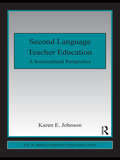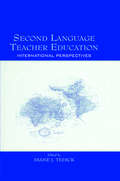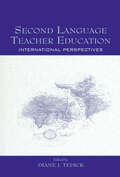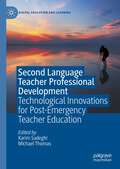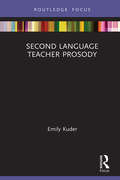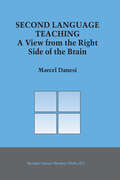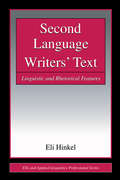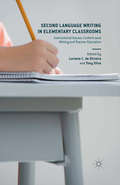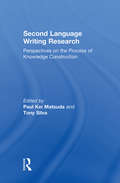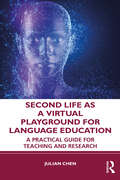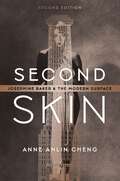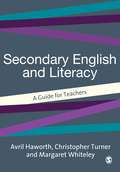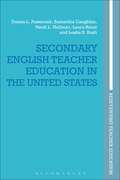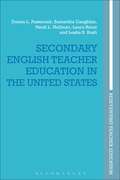- Table View
- List View
Second Language Teacher Education: A Cognitive and Evidence-Based Perspective
by Professor Alessandro G. BenatiHow do students acquire a second language? How can teachers most effectively teach a second language? How do students and teachers develop communication in the language classroom? This textbook is written specifically for a language teacher education programme. It provides teachers with the opportunity to move away from a belief-based teaching approach to a fact-based teaching approach in order to connect knowledge and evidence with innovation. Alessandro G. Benati structures this book around ten key questions that have driven the field of second language learning and language teaching. This provides readers with a clear understanding of: · the relationship between theory and research in second language acquisition and language teaching· the nature and role of language and communication· the results and implications of classroom-based research Pedagogical features in each of the ten units include: call-out boxes highlighting main ideas, further clarification sections to explain key terms, tasks and quizzes at the end of each unit to consolidate learning, and a teacher education evaluation form at the end for readers to reflect on the programme.
Second Language Teacher Education: A Sociocultural Perspective (ESL & Applied Linguistics Professional Series)
by Karen E. Johnson'… A beautifully written, articulate and compelling argument for a sociocultural perspective on second language teacher education . . . Essential reading for all who wish to understand this perspective.' – David Nunan, University of Hong Kong '…Significant and timely. Johnson is masterful at writing in an engaging, transparent prose about complex concepts. It’s a rare scholar who can write prose like this. Throughout my reading I wanted to engage in dialogue with her – this is a sure sign of a great book." – Diane Tedick, University of Minnesota, USA This book presents a comprehensive overview of the epistemological underpinnings of a sociocultural perspective on human learning and addresses in detail what this perspective has to offer the field of second language teacher education. Captured through five changing points of view, it argues that a sociocultural perspective on human learning changes the way we think about how teachers learn to teach, how teachers think about language, how teachers teach second languages, the broader social, cultural, and historical macro-structures that are ever present and ever changing in the second language teaching profession, and what constitutes second language teacher professional development. Overall, it clearly and accessibly makes the case that a sociocultural perspective on human learning reorients how the field understands and supports the professional development of second language teachers.
Second Language Teacher Education: A Sociocultural Perspective (ESL & Applied Linguistics Professional Series)
by Karen E. Johnson'… A beautifully written, articulate and compelling argument for a sociocultural perspective on second language teacher education . . . Essential reading for all who wish to understand this perspective.' – David Nunan, University of Hong Kong '…Significant and timely. Johnson is masterful at writing in an engaging, transparent prose about complex concepts. It’s a rare scholar who can write prose like this. Throughout my reading I wanted to engage in dialogue with her – this is a sure sign of a great book." – Diane Tedick, University of Minnesota, USA This book presents a comprehensive overview of the epistemological underpinnings of a sociocultural perspective on human learning and addresses in detail what this perspective has to offer the field of second language teacher education. Captured through five changing points of view, it argues that a sociocultural perspective on human learning changes the way we think about how teachers learn to teach, how teachers think about language, how teachers teach second languages, the broader social, cultural, and historical macro-structures that are ever present and ever changing in the second language teaching profession, and what constitutes second language teacher professional development. Overall, it clearly and accessibly makes the case that a sociocultural perspective on human learning reorients how the field understands and supports the professional development of second language teachers.
Second Language Teacher Education: International Perspectives
by Diane J. TedickThe education of second language teachers takes place across diverse contexts, levels, settings, and geographic regions. By bringing together research, theory, and best practices from a variety of contexts (ESL/EFL, foreign language, bilingual and immersion education), this book contributes to building meaningful professional dialogue among second-language teacher educators. Featuring an international roster of authors, the volume is comprised of 18 chapters organized in four thematic sections: the knowledge base of second language teacher education; second language teacher education contexts; collaborations in second language teacher education; and second language teacher education in practice. Second Language Teacher Education: International Perspectives is an essential professional resource for practicing and prospective second language teacher educators around the world.
Second Language Teacher Education: International Perspectives
by Diane J. TedickThe education of second language teachers takes place across diverse contexts, levels, settings, and geographic regions. By bringing together research, theory, and best practices from a variety of contexts (ESL/EFL, foreign language, bilingual and immersion education), this book contributes to building meaningful professional dialogue among second-language teacher educators. Featuring an international roster of authors, the volume is comprised of 18 chapters organized in four thematic sections: the knowledge base of second language teacher education; second language teacher education contexts; collaborations in second language teacher education; and second language teacher education in practice. Second Language Teacher Education: International Perspectives is an essential professional resource for practicing and prospective second language teacher educators around the world.
Second Language Teacher Professional Development: Technological Innovations for Post-Emergency Teacher Education (Digital Education and Learning)
by Karim Sadeghi Michael ThomasThis edited book brings together documented evidence and theoretical propositions on the essential mediating role of digital technology in L2 teacher education and professional development. Topics range from technological affordances in teacher education, to challenges and responses to emergency transition from face to face to virtual professional development, to successful practices of online teacher training courses. Bringing together examples from various countries and contexts of how L2 teacher trainers and trainee teachers view these forced changes and react to them, the volume fills a gap in the use of digital technology in contexts where teacher educators and trainee teachers are not technology-literate and not prepared for technology-oriented education. In addition to a Foreword by Mark Warschauer and Introduction and Conclusion chapters by Editors, the volume features 13 full-length chapters by some of the well-known experts from countries such as Australia, Finland, Mexico, the UK, the USA, Spain, Singapore, Turkey and Sweden.
Second Language Teacher Prosody
by Emily KuderSecond Language Teacher Prosody focuses on the prosodic characteristics of input in L2 Spanish classrooms. Readers are led through descriptions and interpretations of prosodic behaviors based upon teachers’ training and experience, their native or near-native speaker status, and their own comments about their teaching. The analysis culminates with several key discoveries and methodological implications with regard to didactic prosody, research design and methodology, and data interpretation. The conclusion offers future lines of research on SDS prosody including reception studies exploring the relative salience and effectiveness of prosodic cues. Educators can intentionally utilize these tools to achieve pedagogical goals. This book will be of interest to scholars in Applied Linguistics and Instructed Second Language Acquisition.
Second Language Teacher Prosody
by Emily KuderSecond Language Teacher Prosody focuses on the prosodic characteristics of input in L2 Spanish classrooms. Readers are led through descriptions and interpretations of prosodic behaviors based upon teachers’ training and experience, their native or near-native speaker status, and their own comments about their teaching. The analysis culminates with several key discoveries and methodological implications with regard to didactic prosody, research design and methodology, and data interpretation. The conclusion offers future lines of research on SDS prosody including reception studies exploring the relative salience and effectiveness of prosodic cues. Educators can intentionally utilize these tools to achieve pedagogical goals. This book will be of interest to scholars in Applied Linguistics and Instructed Second Language Acquisition.
Second Language Teaching: A View from the Right Side of the Brain (Topics in Language and Linguistics #8)
by Marcel DanesiThis volume offers a practical introduction to the use of neuroscience to teach second languages. It provides information on the relation between how the brain learns and how this can be used to construct classroom activities, evaluates methods, syllabi, approaches, etc. from the perspective of brain functioning. It illustrates how teaching can unfold with actual examples in several languages.
Second Language Writers' Text: Linguistic and Rhetorical Features (ESL & Applied Linguistics Professional Series)
by Eli HinkelThis comprehensive and detailed analysis of second language writers' text identifies explicitly and quantifiably where their text differs from that of native speakers of English. The book is based on the results of a large-scale study of university-level native-speaker and non-native-speaker essays written in response to six prompts. Specifically, the research investigates the frequencies of uses of 68 linguistic (syntactic and lexical) and rhetorical features in essays written by advanced non-native speakers compared with those in the essays of native speakers enrolled in first-year composition courses. The selection of features for inclusion in this analysis is based on their textual functions and meanings, as identified in earlier research on English language grammar and lexis. Such analysis is valuable because it can inform the teaching of grammar and lexis, as well as discourse, and serve as a basis for second language curriculum and course design; and provide valuable insight for second language pedagogical applications of the study's findings.
Second Language Writers' Text: Linguistic and Rhetorical Features (ESL & Applied Linguistics Professional Series)
by Eli HinkelThis comprehensive and detailed analysis of second language writers' text identifies explicitly and quantifiably where their text differs from that of native speakers of English. The book is based on the results of a large-scale study of university-level native-speaker and non-native-speaker essays written in response to six prompts. Specifically, the research investigates the frequencies of uses of 68 linguistic (syntactic and lexical) and rhetorical features in essays written by advanced non-native speakers compared with those in the essays of native speakers enrolled in first-year composition courses. The selection of features for inclusion in this analysis is based on their textual functions and meanings, as identified in earlier research on English language grammar and lexis. Such analysis is valuable because it can inform the teaching of grammar and lexis, as well as discourse, and serve as a basis for second language curriculum and course design; and provide valuable insight for second language pedagogical applications of the study's findings.
Second Language Writing in Elementary Classrooms: Instructional Issues, Content-area Writing and Teacher Education
by Luciana C. de OliveiraSecond Language Writing in Elementary Classrooms focuses on L2 writing in elementary classrooms. It features chapters that highlight research in elementary classrooms focused on the writing development of multilingual children, and research in teacher education to prepare elementary teachers to teach L2 writing and address L2 writers' needs.
Second Language Writing Research: Perspectives on the Process of Knowledge Construction
by Paul Kei Matsuda Tony SilvaIn this original volume, eighteen researchers from different parts of the world reflect on their own research projects, providing insights into key methodological issues in research on second language writing. By offering a glimpse into the process of constructing and negotiating knowledge in the field--the messy space of situated practices of inquiry--it helps to demystify the research process, which can appear in published studies and in introductory methodology guides to be neater and more orderly than it actually is.Taking a broad conception of research as inquiry that emphasizes the situated and constructed nature of knowledge in the field, Second Language Writing Research: Perspectives on the Process of Knowledge Construction encourages multiple forms of inquiry, including philosophical, narrative, and historical modes. Empirical inquiry as presented in this book encompasses both quantitative and qualitative approaches as well as those that strategically combine them. A helpful discussion of the "nuts and bolts" of developing sustainable research programs is also provided. The volume as a whole facilitates a situated, issue-driven research practice. Its unique focus on second language writing research makes it an invaluable resource for both novice and experienced researchers in the field.
Second Language Writing Research: Perspectives on the Process of Knowledge Construction
by Paul Kei Matsuda Tony SilvaIn this original volume, eighteen researchers from different parts of the world reflect on their own research projects, providing insights into key methodological issues in research on second language writing. By offering a glimpse into the process of constructing and negotiating knowledge in the field--the messy space of situated practices of inquiry--it helps to demystify the research process, which can appear in published studies and in introductory methodology guides to be neater and more orderly than it actually is.Taking a broad conception of research as inquiry that emphasizes the situated and constructed nature of knowledge in the field, Second Language Writing Research: Perspectives on the Process of Knowledge Construction encourages multiple forms of inquiry, including philosophical, narrative, and historical modes. Empirical inquiry as presented in this book encompasses both quantitative and qualitative approaches as well as those that strategically combine them. A helpful discussion of the "nuts and bolts" of developing sustainable research programs is also provided. The volume as a whole facilitates a situated, issue-driven research practice. Its unique focus on second language writing research makes it an invaluable resource for both novice and experienced researchers in the field.
Second Life as a Virtual Playground for Language Education: A Practical Guide for Teaching and Research
by Julian ChenThis insightful book offers language teachers and teachers in training the opportunity to delve into 3D virtual worlds and see the benefits they provide for effective language teaching. Based on a decade of experience teaching and researching in Second Life (SL), Chen demystifies the dos and don’ts of SL teaching and research, whilst vividly walking readers through each step of the journey. Written in an accessible, jargon-free, and personalised tone, the book is divided into three parts. Part I builds the foundation in SL research, task-based language teaching (TBLT), and understanding fundamental skills for SL teaching. Part II showcases the author’s SL teaching blog that generously unveils their task-based, SL-enabled lessons, participant observations, critical reflections, and lessons learned from each SL session. Part III is complete with the highlights of the author’s SL research and hands-on resources and tips for readers. Each chapter also features a "Checkpoint" section to gauge reader understanding of chapter content, followed by a "Your Task" section to promote learning by doing in SL. Teachers and curriculum designers will find the well-detailed and guided lesson planning useful when starting their first SL class. Graduate students and novice researchers will also find the systematically recorded data collection helpful for their SL research.
Second Life as a Virtual Playground for Language Education: A Practical Guide for Teaching and Research
by Julian ChenThis insightful book offers language teachers and teachers in training the opportunity to delve into 3D virtual worlds and see the benefits they provide for effective language teaching. Based on a decade of experience teaching and researching in Second Life (SL), Chen demystifies the dos and don’ts of SL teaching and research, whilst vividly walking readers through each step of the journey. Written in an accessible, jargon-free, and personalised tone, the book is divided into three parts. Part I builds the foundation in SL research, task-based language teaching (TBLT), and understanding fundamental skills for SL teaching. Part II showcases the author’s SL teaching blog that generously unveils their task-based, SL-enabled lessons, participant observations, critical reflections, and lessons learned from each SL session. Part III is complete with the highlights of the author’s SL research and hands-on resources and tips for readers. Each chapter also features a "Checkpoint" section to gauge reader understanding of chapter content, followed by a "Your Task" section to promote learning by doing in SL. Teachers and curriculum designers will find the well-detailed and guided lesson planning useful when starting their first SL class. Graduate students and novice researchers will also find the systematically recorded data collection helpful for their SL research.
Second Sight in the Nineteenth Century: Prophecy, Imagination and Nationhood (PDF) (Palgrave Studies in Literature, Science and Medicine)
by Elsa RichardsonThis book explores the phenomenon of second sight in nineteenth-century literature and culture. Second sight is a form of prophetic vision associated with the folklore of the Scottish Highlands and Islands. Described in Gaelic as the An-da-shealladh or ‘the two sights’, those in possession of this extraordinary power are said to foresee future events like the death of neighbour, the arrival of strangers into the community, the success or failure of a fishing trip. From the late seventeenth century onwards, rumours of this strange faculty attracted the attention of numerous scientists, travel writers, antiquarians, poets and artists. Focusing on the nineteenth century, this book examines second sight in relation to mesmerism and phrenology, modern spiritualism and anthropology, romance literature and folklorism and finally, psychical research and Celtic mysticism. Tracing the migration of a supposedly ‘Scottish’ tradition through various sites of nineteenth-century popular culture, it explores questions of nationhood and identity alongside those posed by supernatural phenomena.
Second Skin: Josephine Baker and the Modern Surface
by Anne Anlin ChengThrough the figure of Josephine Baker, Second Skin tells the story of an unexpected yet enduring intimacy between the invention of a modernist style and the theatricalization of black skin at the turn of the twentieth century. Stepping outside of the platitudes surrounding this iconic figure, Anne A. Cheng argues that Baker's famous nakedness must be understood within larger philosophic and aesthetic debates about, and desire for, 'pure surface' that crystallized at the convergence of modern art, architecture, machinery, and philosophy. Through Cheng's analysis, Baker emerges as a central artist whose work engages with and impacts various modes of modernist display such as film, photography, art, and even the modern house.
Second Skin: Josephine Baker and the Modern Surface
by Anne Anlin ChengThrough the figure of Josephine Baker, Second Skin tells the story of an unexpected yet enduring intimacy between the invention of a modernist style and the theatricalization of black skin at the turn of the twentieth century. Stepping outside of the platitudes surrounding this iconic figure, Anne A. Cheng argues that Baker's famous nakedness must be understood within larger philosophic and aesthetic debates about, and desire for, 'pure surface' that crystallized at the convergence of modern art, architecture, machinery, and philosophy. Through Cheng's analysis, Baker emerges as a central artist whose work engages with and impacts various modes of modernist display such as film, photography, art, and even the modern house.
The Second World War in Contemporary British Fiction: Secret Histories
by Victoria StewartFocusing on the upsurge of interest in the Second World War in recent British novels, this monograph explores the ways in which secrecy and secret work - including code-breaking, espionage and special operations - have been approached in representations of the war. It considers established writers, including Muriel Spark, Sarah Waters and Kazuo Ishiguro, as well as newer voices, such as Liz Jensen and Peter Ho Davies. The examination of the after-effects of involvement in secret work, inter-generational secrets in a domestic context, political allegiance and sexuality shows how issues of loyalty, deception and betrayal are brought into focus in these novels. Key Features * Breaks new ground in considering the Second World War in contemporary culture * Contributes to debate on established novelists such as Muriel Spark * Intervenes in ongoing debates about historical fiction
The Second World War in Contemporary British Fiction: Secret Histories
by Victoria StewartFocussing on the upsurge of interest in the Second World War in contemporary British novels, this monograph considers established writers, including Muriel Spark, Sarah Waters and Kazuo Ishiguro, as well as newer voices, such as Liz Jensen and Peter Ho Davies, exploring the range of ways in which secrecy in particular has become a focal point for representations of the war.
Secondary English and Literacy: A Guide for Teachers (PDF)
by Dr Avril Haworth Dr Christopher Turner Dr Margaret J Whiteley`Potential readers will want to know why they should buy this rather than any of the other books currently available about teaching secondary English. The answer, I would suggest, is that it is a reassuring, dependable introductory guide to professional practice...and its encouragement to arouse curiosity about language' - English Drama Media `This is an excellent text. It's a very useful, easily accessible, up-to-date addition to the English teacher-training market... very appealing and ahead of any other books in this area' - Bernadette Fitzgerald, PGCE Secondary English Course Leader University of West of England Are you following one of the "non-traditional" routes into English and literacy teaching? Are you looking for a book to accompany your studies on your one-year Teacher Training course? Or have you been teaching secondary English for a while and want to revisit the ideas that engaged you so enthusiastically when you were training? This book encourages readers to become the best kind of secondary English teacher. The authors engage in practical applications of ideas and approaches, and present a rigorous and informed view of the subject, that is at the same time professionally and practically focused. Based on theorized and researched understandings of the essential nature of language and texts, the authors put forward a view of the subject which connects with current trends in the teaching of English and literacy. Whether it is used as a main or companion text, or for self-study, this book offers exciting perspectives on the teaching of English and literacy. The authors are a team of experienced English teachers who are now university tutors. They have worked successfully with trainee secondary English teachers over many years.
Secondary English in Action
by Sam Chater Lucy McConaghyWith more than 20 years teaching experience between them, the authors of Secondary English in Action share clear examples of a range of strategies for teachers of secondary English, summarising research and thinking on approaches within English teaching while maintaining a focus on application in the classroom to inspire enthusiasm and love for English.Not bounded by the constraints of current examination frameworks but a vision of what experiencing English should be for a student, this book covers teaching students how to use oracy appropriately, how to interpret texts fully and how to create their own texts accurately and with purpose.McConaghy and Chater make the case for the importance and value of English, along with a range of ways to promote engagement and uptake and so, whether you are beginning your journey into teacher training, working as a teaching assistant or are an experienced teacher looking for new inspiration and ideas, this is an essential guide for all English classroom-based staff.
Secondary English Teacher Education in the United States (Reinventing Teacher Education)
by Donna L. Pasternak Samantha Caughlan Heidi L. Hallman Laura Renzi Leslie S. RushWinner of the ELATE Richard A. Meade Award 2018 Identifying key areas of teacher education that cross countries and disciplines, this book provides the first extensive research-based insight into how secondary English teachers are prepared at institutions of higher education in the United States of America (US) since the last major study in 1995. In the two decades since then, English teacher education programs have developed in contextually dependent ways that often have been driven by institutional, economic, social and political considerations.The authors provide an overview of their nationwide study of English teacher educators, which was conducted over a four-year period. They analyze the context under which teacher educators currently prepare pre-service English teachers in the US and support teacher educators in other countries to make comparisons to their own unique historical and cultural settings. The authors also offer a comprehensive evaluation of the content, practices and skills being taught to future teachers of English in university-based teacher preparation programs in the US. The book draws on evidence from a nationwide questionnaire, case studies of teacher educators in their respective programs, course syllabi and focus group interviews to focus on areas of instruction that resonate with teacher educators in countries where English is the dominant language of communication. These areas include:- field experiences- standards and assessment- teaching literacy to integrate reading and writing- working with English language learners to address cultural and linguistic diversity- new technologies in English education
Secondary English Teacher Education in the United States (Reinventing Teacher Education)
by Donna L. Pasternak Samantha Caughlan Heidi L. Hallman Laura Renzi Leslie S. RushWinner of the ELATE Richard A. Meade Award 2018 Identifying key areas of teacher education that cross countries and disciplines, this book provides the first extensive research-based insight into how secondary English teachers are prepared at institutions of higher education in the United States of America (US) since the last major study in 1995. In the two decades since then, English teacher education programs have developed in contextually dependent ways that often have been driven by institutional, economic, social and political considerations.The authors provide an overview of their nationwide study of English teacher educators, which was conducted over a four-year period. They analyze the context under which teacher educators currently prepare pre-service English teachers in the US and support teacher educators in other countries to make comparisons to their own unique historical and cultural settings. The authors also offer a comprehensive evaluation of the content, practices and skills being taught to future teachers of English in university-based teacher preparation programs in the US. The book draws on evidence from a nationwide questionnaire, case studies of teacher educators in their respective programs, course syllabi and focus group interviews to focus on areas of instruction that resonate with teacher educators in countries where English is the dominant language of communication. These areas include:- field experiences- standards and assessment- teaching literacy to integrate reading and writing- working with English language learners to address cultural and linguistic diversity- new technologies in English education

